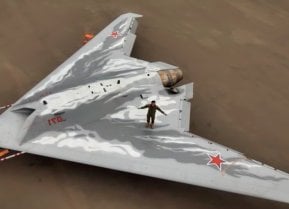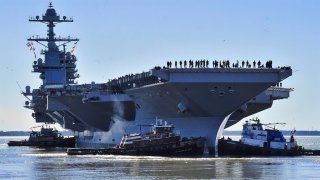Ford-Class: The Most Expensive, Largest and Most Powerful Aircraft Carrier Ever
The Ford-class aircraft carriers are the most expensive, largest, and most powerful carriers ever built and packed with new technology.
The US Navy is contemplating the future, most particularly, the prospect of war in the Indo-Pacific against a near-peer rival in China. Accordingly, the US Navy is updating its inventory, beginning with the cornerstone of their fleet, the aircraft carrier.
In replacing the outdated Enterprise- and Nimitz-class carriers, the Navy is currently building the most expensive warship ever developed, the Gerald R. Ford-class – each of which costs $13 billion. The cost of each Ford carrier is mild relative to the costs of the program, which incorporates several new pieces of technology, and has cost US taxpayers in excess of $120 billion.
Ford-Class: The Best of the Best in Aircraft Carriers?
The taxpayers are expecting to receive what they paid for – that being the best aircraft carrier ever built.
So far, thanks to a slew of new tech features, the Ford indeed appears to be the most sophisticated and modern carrier ever built. Let’s consider the Ford-class’s five most important features.
One, Sortie Generation Rate
Despite an aircraft carrier’s mechanical complexity, the purpose of the boat is quite simple: to provide off-shore airpower projection. Really, an aircraft carrier is just a floating and movable airfield that can be placed roughly anywhere in the world’s oceans.
So, to be effective, an aircraft carrier needs to be able to launch aircraft. It sounds self-evident, yes, but the rate at which an aircraft carrier can launch aircraft is a primary metric in evaluating the usefulness of a particular aircraft. The metric even has a name: Sortie Generation Rate (SGR). And the higher the SGR, the better.
The Ford-class is projected to provide an excellent SGR – 33 percent more than the preceding Nimitz-class carriers. Overall, the Ford is expected to produce 160 sorties per day (270 during a wartime crunch). The high SGR makes the Ford highly effective with respect to the boat’s primary task of projecting airpower.
Two, Electromagnetic Aircraft Launch System (EMALS)
The Ford is equipped with an Electromagnetic Aircraft Launch System, or EMALS, which is a modern alternative to the traditional steam piston catapult found on older aircraft carriers like the Nimitz and Enterprise. Whereas steam catapults use (as the name implies) steam to catapult an aircraft down the carrier’s truncated runway, the EMALS uses a linear induction motor. The EMALS’s linear induction motor generates magnetic fields that glide an airplane forward along a track.
The EMALS is considered an upgrade over the steam piston catapult because the EMALS will accelerate aircraft more smoothly (putting less wear and tear on the airframes).

Also, the EMALS will cost less, weigh less, and require less maintenance than the steam piston catapults. Additionally, the EMALS will reduce the Ford’s dependence on freshwater (and the corresponding energy-intensive desalination process). EMALS also recharges more quickly than steam, allowing for more aircraft launches (and a higher SGR).
Three, Advanced Arresting Gear System (AAG) for Ford-Class
The Advanced Arresting Gear System, or AAG, will replace the MK7 hydraulic arresting gear found on older aircraft carriers like the Nimitz and Enterprise. The AAG was built to handle a wider range of aircraft than the MK7, while using less manpower, and requiring more maintenance. The result is an arresting gear system that is more hands-off, yet can handle more aircraft.
The AAG uses rotary engines and water turbines paired with a large induction motor. The result is fine control of arresting forces – generated through a simple process. The AAG is less groundbreaking than the EMALS, but still offers an upgrade over preceding systems (and still boosts the Ford’s SGR).
Four, Manpower Reduction
Aircraft carriers are essentially floating cities. Well, maybe not cities but towns.
The Nimitz-class carrier, for example required 5,000 sailors to operate. So, inherent to the operations of the Nimitz was the feeding, housing, and paying of 5,000 people – in itself a complicated and expensive endeavor.
When designing the Ford, an effort was made to reduce the boat’s reliance on manpower; much of the Ford is built to run with automated technologies in place of sailors. The result is a carrier that needs 1,100 fewer sailors to operate than the Nimitz had needed. The 20 percent reduction in manpower requirements is expected to lead to long-term cost savings.
Five, Maintenance Reduction
The Ford was designed to operate with less maintenance than preceding aircraft carriers. So, with reducing maintenance in mind, the Ford was built with simpler nuclear reactors than the Nimitz or Enterprise. Similarly, the radar system was designed to be less finicky. And the EMALS and AAG were designed to require less maintenance than the preceding steam catapults and MK7 arresting gears.
In sum, the Ford should require significantly less maintenance over the course of its 50-year service life than older aircraft carriers required. Cost projections suggest that the Ford will save $4 billion in maintenance costs during its fifty years in service.
About the Author
Harrison Kass is a defense and national security writer with over 1,000 total pieces on issues involving global affairs. An attorney, pilot, guitarist, and minor pro hockey player, Harrison joined the US Air Force as a Pilot Trainee but was medically discharged. Harrison holds a BA from Lake Forest College, a JD from the University of Oregon, and an MA from New York University. Harrison listens to Dokken.


